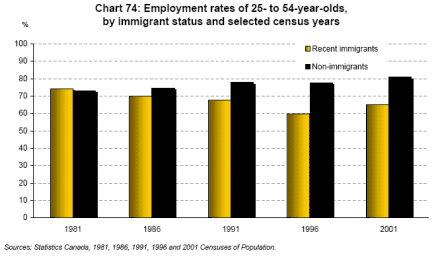

|
 |
Table of contents > Section N - Immigrants >
Employment rates, by immigrant status and selected census years
The gap in employment rates between recent immigrants and native-born Canadians remains despite the expansion of late 1990s
- Despite the economic boom of the late 1990s, the 2001 employment rate of immigrants aged 25 to 54 years who had arrived in Canada during the previous five years continued to lag substantially behind that of native-born Canadians of the same age (65.2% versus 80.9%).
- The employment rate gap between recent immigrants and native-born Canadians aged 25 to 54 has changed considerably over the years. In 1981, new immigrants were more likely to be employed (74.2%, compared with 73.1% for non-immigrants). By 1986, the situation was reversed, since the rate for recent immigrants was falling while that of native-born Canadians was rising. The gap continued to widen, increasing to 18 percentage points in 1996 but then narrowing slightly, to 16 points, in 2001.
- Labour market problems faced by recent immigrants tend to be similar to those encountered by young people, since both are often new entrants to the Canadian labour market. Common challenges for both groups could be their lack of Canadian work experience and of a well-established network of contacts.
- However, the employment rates of immigrants are known to rise with the number of years they have resided in Canada. For example, 78.6% of immigrants aged 25 to 54 who had been in the country for 11 to 15 years were employed in 2001, compared with 65.2% of recent immigrants of the same age. Those who had been in Canada for 16 years or more had a slightly better chance than native-born Canadians to be employed in 2001 (81.9% versus 80.9%).
Enlarge chart
|


